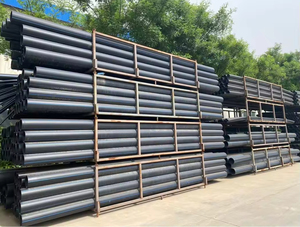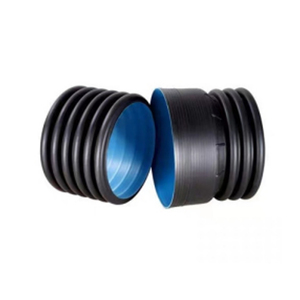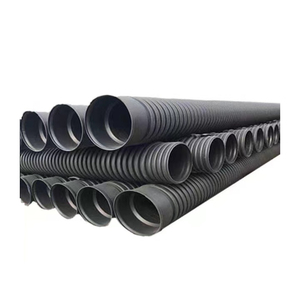(625 products available)
















































































































































































































HDPE tube for sewer is a thermoplastic material used to manufacture pipes and tubes for various applications. These tubes are lightweight and flexible, making them a preferred option in the construction industry.
HDPE tubes have a high density, making them more robust than other plastics. They are used in applications where strength and durability are essential. These tubes are resistant to impact, damage, and harsh environmental conditions.
HDPE tubes are widely used for sewers and drainage systems due to their corrosion resistance. They can withstand exposure to chemicals, sewage waste, and other materials without degrading or corroding over time. This makes them a reliable option for sewer systems.
These tubes have a smooth inner surface, which allows for the seamless flow of liquids and reduces friction. This is crucial for sewer systems where the primary purpose is to transport wastewater efficiently.
HDPE tubes are popular due to their flexibility. They can bend and curve without breaking, allowing for easy installation in complex sewer layouts and reducing the need for additional fittings and joints. This flexibility also means these tubes can absorb ground movement without cracking, making them ideal for areas with unstable soil conditions.
When it comes to sewer applications, HDPE comes in various diameters and sizes. This allows engineers to choose the right size of the tube based on the volume of wastewater that needs to be transported. Larger diameters are suitable for major sewer lines, while smaller ones can be used for drainage.
In addition, HDPE tubes are eco-friendly, meaning they can be recycled. They are also used to manufacture other products, making them a sustainable option in the construction industry.
When sourcing these tubes, it is essential to consider their wall thickness. HDPE tubes with thicker walls are more durable and can withstand higher pressure levels. In contrast, those with thinner walls are ideal for low-pressure sewer applications and drainage systems.
There are a number of features and functions of an HDPE sewer tube that make it a popular choice for drainage systems. These include:
Corrosion resistant
Because they are not affected by chemicals and acids, HDPE drainage pipes are excellent for sewage or stormwater applications. In addition, they resist oxidation and corrosion from moisture, which is frequently found in sewer systems.
Lightweight and flexible
Due to their low density, polyethylene pipes are simple to handle, transport, and install. When installing in places with challenging soil conditions or where seismic activity is a concern, their flexibility enables them to bend without breaking.
High impact resistance
These tubes are made to survive hard knocks, scrapes, and bangs during installation and throughout their useful lives. This robustness guarantees that the pipes won't crack or break easily, which would cause costly repairs and replacements.
Joint integrity
When heat fusion techniques are used to connect HDPE pipes, they form connections that are as strong and durable as the pipe itself. This watertight jointing technique guarantees a continuous flow and lessens the chance of leaks, which is crucial for sewage systems.
Excellent flow characteristics
Due to their smooth interior surfaces, HDPE sewer pipes provide exceptional hydraulic properties, which facilitate fluid movement and reduce turbulence and blockage. Furthermore, their smooth surface makes it simple to clean them and stop debris from accumulating.
Long service life and durability
HDPE sewer pipes have a long lifespan, often lasting 50 years or more. They can endure extreme temperatures, intense sunlight, and severe weather, making them perfect for above-ground and underground applications.
Easy to recycle and reusable
Polyethylene is a material that can be recycled. This makes HDPE tubes a more environmentally friendly choice. At the end of their useful lives, these pipes can be recycled to create new products, which helps to conserve resources and reduce waste.
When considering applications of an HDPE tube for sewers, think of projects involving drainage, irrigation, and electrical wiring. These tubes are popular because of their high-density polyethylene material, which makes them resistant to pressure, corrosion, and temperature changes.
They are used in municipal projects, agricultural settings, and construction sites. Some common applications include:
When selecting an HDPE tube for sewer projects, it is important to consider various factors to ensure the appropriate selection of products. This will lead to a more robust and reliable sewer system.
Diameter and Size:
First, determine the appropriate sewer line diameters and sizes required for various applications. Larger diameters are suitable for municipal sewer systems, while smaller diameters are ideal for residential and commercial construction projects.
Pressure Rating:
An HDPE drainage pipe is ideal for applications with different pressure ratings. Evaluate the expected pressure in the sewer system and select a tube with a suitable pressure rating. Look for tubes with a durable construction, as they provide longevity and resistance to rupture.
Wall Thickness:
The wall thickness of an HDPE drainage pipe significantly impacts its durability and performance. Consider selecting a tube with a thicker wall, as it provides more strength and resistance to external pressure, impacts and soil movement. The wall thickness directly correlates with the robustness of the drainage system.
Jointing Methods:
It is important to consider how the tubes will be connected. Look for jointing methods like electrofusion and butt fusion that offer a seamless and more robust connection.
Compatibility:
Ensure the HDPE tube is compatible with other materials used in the sewer system. This will ensure seamless connectivity and functionality. Consider tubes like PVC, concrete and VCP. Compatibility minimizes friction and enhances the flow of sewage.
Environment Factors:
Consider factors like soil type, temperature, terrain and anticipated loads. Acknowledge the soil type and temperature range to ensure the selected HDPE sewer tubes can withstand environmental conditions. These factors affect the performance and longevity of the drainage systems.
Q1. What is the minimum temperature that can be used with an HDPE sewer pipe?
A1. The pipes can be used in environments with temperatures above 0 degrees Celsius. At this point, the pipes will not freeze and can be easily installed.
Q2. How are HDPE pipes joined together?
A2. There are various methods of welding HDPE pipes. These include electrofusion, butt fusion, and socket fusion. Butt fusion is the most common method used in HDPE welding.
Q3. What does a sewer pipe look like?
A3. A sewer pipe is usually black on the outside and a little shiny on the inside. It can be seen in the ground near buildings or homes, carrying water from toilets and sinks to the treatment plant.
Q4. What are the three types of HDPE welding?
A4. The three types of HDPE welding include electrofusion, butt fusion, and socket fusion. The choice of technique depends on the pipe diameter and the area of operation.
Q5. What is the average lifespan of HDPE sewer pipes?
A5. High-density polyethylene (HDPE) sewer pipes have an impressive lifespan, often exceeding 50 years. In some cases, these pipes can last for 60 years or more with proper installation and maintenance.